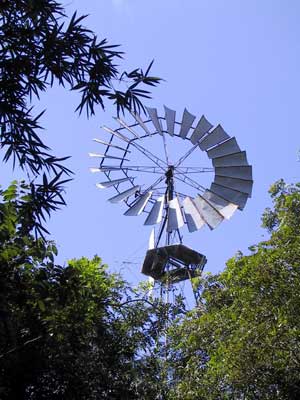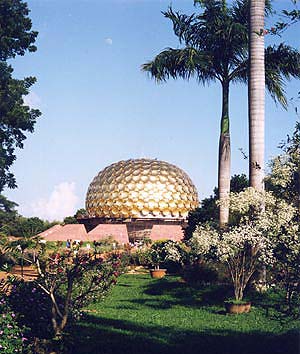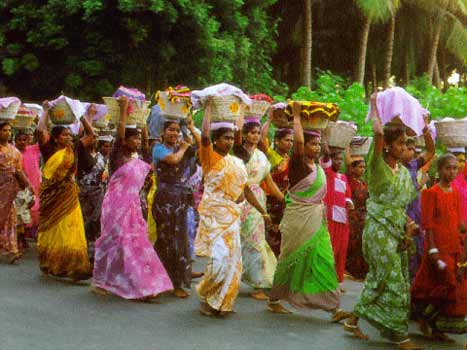





 |
 |
 |
 |
 |
 |
 |
|
1.9
PHYSICAL AND SOCIAL |
||
|
1.9.1 Road Network: Auroville's road network consists of access roads, which are tarred but narrow and not well maintained and connect the East Coast Road and Tindivanam-Pondicherry road with village settlements, internal gravel roads, footpaths and cycle tracks. Most of the internal roads are of a temporary nature giving access to residential communities and public facilities. The gravel roads are about 10 m. wide. The total length of roads within the designated township area is 23.7 km. The principal access roads and internal linkages indicated in the Existing Land Use Map (Drawing 4) show that the area is well served with a road network. The existing road pattern is comprised of one circular road around the centre of the township and another semi-circular road passing along the periphery (outer circle) of the designated area of the township. Both the inner and the outer circular roads are connected by radial roads. The surface of the internal access as well as circular road has intentionally been kept as gravel to allow percolation of rainwater for re-charging the aquifers. Conceptually these are maintained as pedestrian roads, but slow moving traffic consisting of cycles and scooters is slowly and steadily increasing. With the increase of tourists and visitors to the Matrimandir area, the motorised traffic consisting of cars and buses also increased, particularly on holidays and weekends. Apart from missing links in the outer circular road in the eastern part of the township, the road network in the township is devoid of street furniture, signage and indicators. Geometrics of the major linkages to the township both from the East Coast road and the Tindivanam-Pondicherry road, as well as of the internal roads, access and approaches need to be improved. |
|
|||||||||||||||
|
1.9.2 Water Supply: The entire water supply both for drinking and irrigation is dependent on underground sources. A number of deep wells have been commissioned over the last 30 years and today there are over 130 wells, of which 60 wells give a significant output. They can together provide an average water supply of 3800 cu.m. per day, amounting to 1.4 million cu.m. annually. Auroville is however located in a district where the ground water situation can be described as 'critical' since nearly 90% of the recharge potential is utilised. It therefore becomes important not only to increase the recharge rate but also conserve and recycle water. Taking note of this situation, Auroville is engaged in extensive water management research and application. |
|
|||||||||||||||
|
 Waste water treatment plant |
|
|||||||||||||||
|
|
||||||||||||||||
|
1.9.4 Sewerage and Sanitation: All residential units have their own system for sewage disposal. There are about 20 community-level treatment facilities (for residential as well as industrial and commercial units) consisting of septic tanks, Imhoff tanks, baffle reactors, and root zone and lagooning systems. The latter, numbering 22, are of experimental nature, and a study has been taken up to test their efficacy in delivering waste water that will not pollute the ground water. |
|
|||||||||||||||
|
1.9.5 Solid waste disposal is managed by the Eco Service, which was started in 1995. It is estimated that about 3500 kg of wastes are generated per week. About 2000 kg. of this quantity is organic and generally composted at the site itself. About 1000 kg. is recycled and the balance of 500 kg is incinerated in the Health Centre at 800 °C. The non-recyclable wastes of 400 to 500 kg, like rubber items, thermocole, fibreglass and PET, and storage batteries are stored in a temporary storage facility until an acceptable disposal solution is found. This waste disposal management has been made possible by the introduction of segregation of wastes at the source. |
|
|||||||||||||||
|
1.9.6 Power:
Auroville consumes about 1.75 million kilowatts of power/year from two
TNEB feeder stations, one in Kalapet and the other one at Thiruchitrambalam.
The total connected load is 3.17 megawatts, of which 1.5 megawatts are
domestic and the rest is for industrial and commercial purposes. |
|
|||||||||||||||

|
|
|||||||||||||||
|
1.9.7 About 150 houses use solar PV electricity and heaters for their energy requirements. In addition, there are about 140 solar water-pumping systems and 30 wind-driven pumps. The power distribution of around 600 consumer connections is carried through a system of 28 distribution transformers and 30 km of underground cables. |
||||||||||||||||
|
1.9.8 Telephones and Communication: The Township is served by a telephone exchange with a capacity of 1000 lines, which is fully utilised. There is also a small post office located in Bharat Nivas which exclusively serves Auroville. Auronet, Auroville's email and electronic bulletin board network, both within Auroville and with the outside world, has currently about 750 subscribers. The township has its own internal messenger service and the weekly Auroville News provides information about the happenings in Auroville to all the residents. |
|
|||||||||||||||
|
1.9.9 Auroville publishes for internal as well as external circulation two regular newsletters in English, and one in Tamil. English-language newsletters are the monthly 'Auroville Today' and the quarterly 'Auroville Outreach' , and 'Kaliveli Nilam' is in Tamil. Auroville is equipped to handle its information and outreach through well-established printing and multimedia resource units. |
||||||||||||||||
|
1.9.10 Cremation and Burial Ground: At present, there is one burial ground within Auroville, which is used by villagers. There is no regular burial or cremation facility for the Aurovilians as such, but a site for this purpose has been chosen near Adventure community in the southern part of the Green Belt. |
|
|||||||||||||||
|
1.9.11 Education: Auroville educational research endeavours to nurture the child's potential to its highest possible level, and is based on a child-centred approach. At present, there are two crèches, one kindergarten, two primary schools (Transition and Deepanam), and three high schools (Last School, Centre for Further Learning and After School) for children residing in Auroville. All these educational facilities are located within walking distances and are well-dispersed in the township. New high school facilities are presently under construction. There are also four schools (New Creation, Isaiambalam, Arul Vazhi and Ilaignarkal) specifically serving the surrounding villages.
|
|
|||||||||||||||
 |
||||||||||||||||
|
1.9.12 About 700 children from 13 surrounding villages and from Auroville are studying in these institutions. The schools use innovative learning and teaching methods and also provide playground and sports facilities appropriate to the age level. The Sri Aurobindo International Institute for Educational Research (SAIIER), an organisation established in 1984, co-ordinates the multi-faceted educational and cultural activities in Auroville. |
|
|||||||||||||||
|
1.9.13 Health: The Auroville Health Centre, recognised as a mini health centre by the Tamil Nadu State Government, is equipped with basic medical facilities. It serves the Auroville community as well as about 200 patients daily from the villages, and has six sub-centres, located in Edayanchavadi, Putthurai, Kottakarai, Matthur, Rayapudupakkam and Morattandi. |
||||||||||||||||
|
1.9.14 For emergencies and complicated cases, patients are referred to the health facilities in Pondicherry, which is just 6 km away. Auroville also experiments with and promotes various alternative healing methods and natural therapies. |
|
|||||||||||||||
|
1.9.15 Tourist Infrastructure: The infrastructure within Auroville for visitors and tourists consists of information centres, guest houses, and the Visitors Centre which has an information service, a boutique and a restaurant. The guest houses can accommodate altogether about 400 persons in a simple, clean and green environment at a moderate price. Dormitory accommodation for youth and young researchers is also provided. Parking facilities can provide space for 20 buses at any time. |
||||||||||||||||
|
|
|
|||||||||||||||
|
1.9.16 Recreation: Auroville provides for children and youth of Auroville and the residents of the surrounding villages a broad array of sports and physical education activities, and aims to maximize these opportunities in the region. The township has presently four play fields for various outdoor sports, such as tennis, football, volleyball and badminton, and a gymnasium and indoor sports facilities. It organises on a regular basis team games and athletic meets, and competitions in basketball, volleyball, football, table tennis and cricket. Many of the participants for these competitions come from the surrounding villages. Although the Auroville township area is away from the coast line, it has developed beach facilities at 'Repos', near Chinnamudaliarchavadi village. |
|
|||||||||||||||
|
1.9.17 Socio-Cultural Facilities: Auroville has become a hive for socio-cultural activities serving both Auroville residents and their neighbours. The most important facilities include the Sri Aurobindo Auditorium at Bharat Nivas with a sitting capacity of 840 persons. Workshops and recitals of both traditional and modern dance, drama and music are regularly held. Several groups are active in providing cultural events based on community and environmental awareness programmes |
||||||||||||||||
|
1.9.18 Spiritual Centre: The Matrimandir, the spiritual as well as the physical centre of Auroville, is in the Mother's words, "the symbol of the Divine's answer to man's aspiration for perfection, union with the Divine manifesting in a progressive human unity". The Matrimandir is a place of silence and concentration. |
|
|||||||||||||||
|
 The Matrimandir |
|
|||||||||||||||
|
1.9.19 The major areas of work on the structure are under completion and attention is being given to the development of the surrounding gardens. The Matrimandir together with its gardens extends over an area of 28 ha. The growth of the Matrimandir and its movement towards a perfect completeness reflects and signals the growth and increasing perfection of Auroville as a whole. |
||||||||||||||||
|
|
|
|||||||||||||||
|
1.9.20 Village
Outreach: Auroville's development is inextricably intertwined with
the surrounding villages, which were classified in 1984 as part of a "most
backward area in need of development" by the Tamil Nadu Government. There
are 13 villages in the immediate area of Auroville, comprising about 40,000
people, and there are altogether 40 villages in the bioregional area.
About 350 people from the surrounding villages have joined Auroville.
Almost 5,000 local people are employed by Auroville, from sweepers to
engineers; most of them have been trained in Auroville to improve their
qualifications and skills. Auroville provides for the young of the rural
area a real and viable alternative to the migration to the cities and
urban centres, which is so often the only option for those seeking self-improvement
and employment.
|
|
|||||||||||||||
|
1.9.21
Village development has been a major activity of Auroville since its inception.
Over the past 13 years, the Auroville village development groups (AVAG,
Health Centre, Pitchandikulam, Harvest, Palmyra) have been engaged in
a development programme for the neighboring villagers. With funding from
a number of national and international organizations, this program aims
at:
|
|
|||||||||||||||
 |
|
|||||||||||||||
|
1.9.22
At present, there are five major educational programs for village children
such as New Creation (with boarding facilities), Ilaignarkal, Isai Ambalam,
Life Education Center and Arul Vazhi, a program that sends animators to
the village schools for regular classes and special activities. |